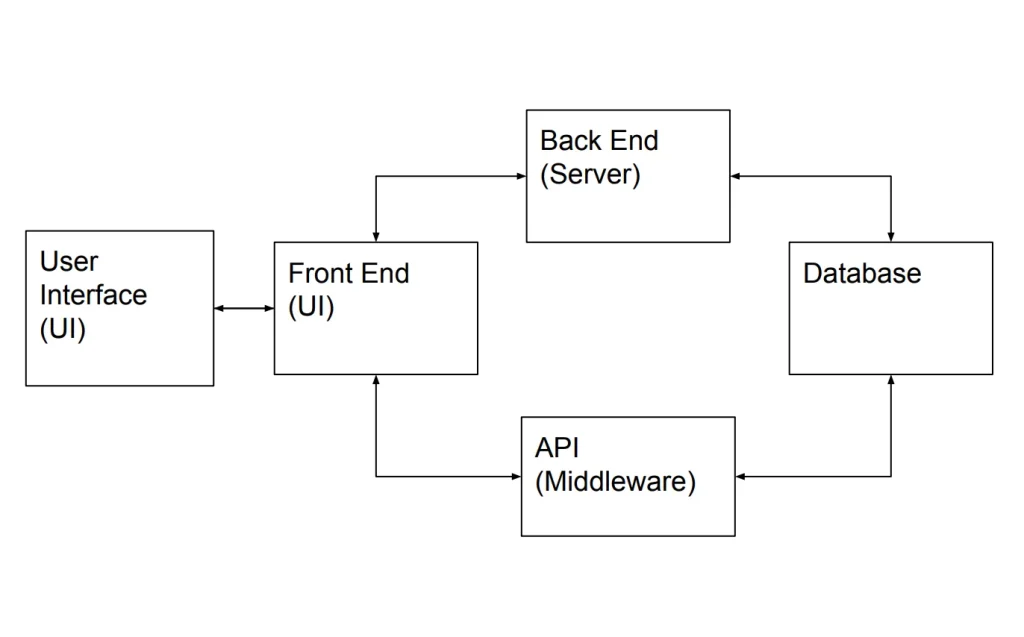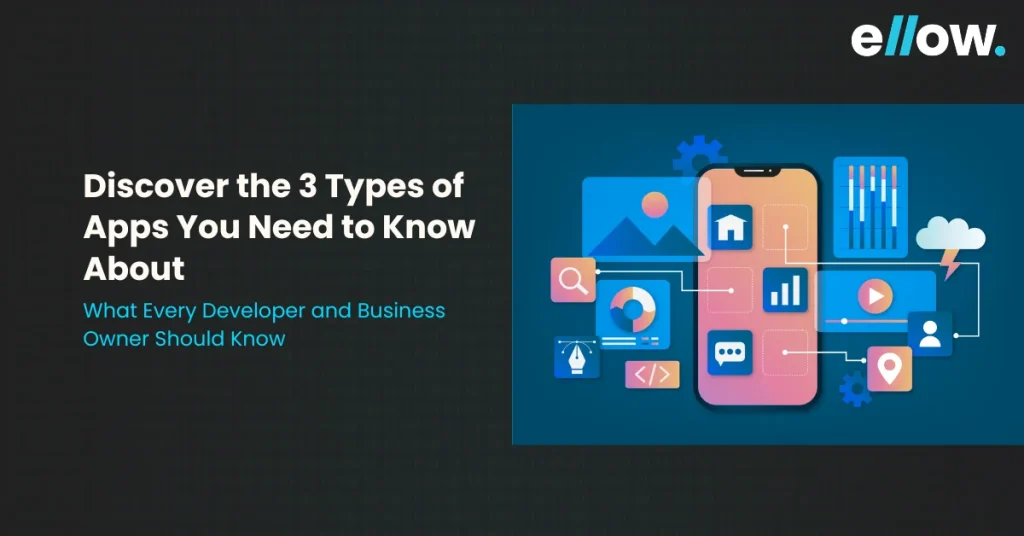Mobile apps are an integral part of our daily lives, driving a substantial portion of our online interactions. With over 218 billion app downloads projected globally in 2024, understanding the different types of mobile apps is essential for businesses looking to develop their own.
There are three main types of mobile apps: native, web, and hybrid.
Each type has its unique features, benefits, and limitations. This article explains these distinctions clearly, helping you decide which type of app best suits your business needs.
By understanding the nuances of each, you can better navigate the app development process and select the right approach for your goals.
What Is an App?
An app is a self-contained software package that helps users perform specific tasks on mobile or desktop devices. Apps can be pre-installed on devices or downloaded from app stores like the Apple App Store.
Apps are created using different programming languages. For example, Android apps are made with Kotlin, Java, and C++, while iOS apps use Swift and Objective-C within the Xcode development environment.
These apps are packaged into files like APK for Android and IPA for iOS, including all the necessary code, data, and resources to run the app.
Key Components of an App
1. Activities
An activity is the main entry point for users. It is displayed through a user interface (UI) and allows users to interact with the app.
For instance, in a social media app like Instagram, one activity might show user-recorded videos, another could offer options to create posts, and another might display posts from other users.
While these activities work together to provide a smooth user experience, each one operates independently.
2. Services
A service runs in the background and performs tasks without a user interface. For example, a music app might use a service to play songs while the user does other things on their device.
Services ensure that background tasks continue to function even when the user is not directly interacting with the app.
3. Broadcast Receivers
Broadcast receivers allow an app to respond to system-wide announcements or events. For example, a reminder app can alert you about an upcoming event without needing to stay active all the time. Broadcast receivers let the app react to events like alarms or notifications even when it’s not currently running.
4. Content Providers
Content providers manage and share data between apps. They allow apps to store data in a centralized location that other apps can access with permission. For example, a content provider might link different apps to a shared database, enabling them to query or modify data as needed.
5. App Resources
Apps use various resources beyond the source code, such as images, audio files, and other visual elements. These resources allow users to customize and optimize the app for different devices and preferences.
For example, an app might have different layouts for different screen sizes or languages, all defined using XML files. These resources help make the app adaptable to various device configurations.
These components are crucial as they enable apps to be flexible and functional across different devices and use cases.
How Do Apps Function?
Apps allow users to interact with them through a user interface (UI), which is part of the app’s front end. The front end processes the user’s request and sends it to the backend. Both the front end and back end are important without a working back end, the front end can’t function effectively, and vice versa.
The frontend and backend communicate via APIs (Application Programming Interfaces). Let us take an example to understand this better.
Consider the e-commerce app ‘eBay’ which uses Google Cloud to provide e-commerce services. If a user wants to buy a winter jacket, they tap the ‘buy now’ button and proceed to the checkout page to choose a payment option.
Here, the eBay frontend sends the user’s request to the backend servers, which connect to the payment gateway.
In this case, the API facilitates two-way communication between the front end and back end. It also connects to the external payment provider, displaying the payment page for the user. The API ensures the app remains active until the transaction is complete, allowing the user to make the purchase.
The backend is the ‘brain’ of any mobile app, handling data processing, storage, and security. For example, retrieving the jacket selected by the user from the database is the backend’s job. The backend runs on remote servers and delivers app features to the user via APIs.
The backend extends app functionality beyond the capabilities of a typical smartphone, providing a seamless frontend experience without having a user interface itself. It enables communication between devices and servers, ensuring a smooth user experience.
Block Diagram
Below is a block diagram illustrating how apps work:

- User Interface (UI): Users interact with the app through the frontend UI.
- Frontend: The frontend processes the user’s request.
- API (Middleware): The API facilitates communication between the front end and the back end.
- Backend: The backend processes the request, retrieves data from the database, and performs necessary actions.
- Database: Stores the data required by the app and is accessed by the backend.
This block diagram shows the flow of data and actions from the user’s interaction with the app to the backend processing and back to the user.
Recommended Reads: Best programming language for mobile app development in 2024
Types of Apps
1. Native Mobile Apps
Native mobile apps are applications specifically developed for a particular mobile operating system, such as iOS or Android. This means they are designed to take full advantage of the features and functionality of that specific platform.
Technologies Used
- iOS: Swift and Objective-C are the primary languages used for iOS development. Swift is newer and more preferred for its safety, performance, and modern syntax.
- Android: Java and Kotlin are the main languages for Android development. Kotlin, being a newer language, is favored for its expressive syntax and compatibility with existing Java code.
Pros of Native Mobile Apps
- Performance
- Speed: Native apps are highly optimized for the operating system they run on, making them faster and more responsive.
- Efficiency: They utilize the device’s processing power and memory more effectively, which results in better performance.
- User Experience
- Consistency: Native apps provide a seamless user experience as they adhere to the specific design guidelines and UI standards of the operating system.
- Responsiveness: They offer smooth navigation and interactions, enhancing overall user satisfaction.
- Access to Device Features
- Hardware Integration: Native apps can fully utilize device features such as the camera, GPS, accelerometer, microphone, and more.
- API Utilization: They have direct access to all the native APIs, allowing for advanced functionalities like augmented reality (AR) and real-time data processing.
Cons of Native Mobile Apps
- Development Cost
- Multiple Codebases: Developing native apps for both iOS and Android means creating and maintaining two separate codebases, which increases development time and cost.
- Specialized Skills: Requires developers proficient in the specific languages and tools of each platform, further driving up costs.
- Maintenance
- Separate Updates: Updates and bug fixes must be implemented separately for each platform, leading to increased maintenance efforts.
- Version Compatibility: Ensuring compatibility with multiple versions of the operating system can be challenging and time-consuming.
- Storage
- Device Space: Native apps typically take up more storage space on the user’s device, including the app itself and any updates or cached data.
Use Cases of Native Mobile Apps
- Gaming Apps: High-performance games often use native development to ensure smooth graphics and responsive gameplay.
- Financial Apps: Banking and financial apps benefit from the security and reliability of native development.
- Social Media Apps: Apps like Facebook and Instagram use native development to provide a rich, interactive experience and integrate deeply with device features like the camera.
Tools for Native Development
iOS
1. Xcode: Integrated development environment (IDE) for macOS containing a suite of software development tools for developing macOS, iOS, watchOS, and tvOS apps.
2. Swift Playgrounds: An app for learning Swift, useful for both beginners and experienced developers.
Android
1. Android Studio: The official IDE for Android development, offering powerful tools for code editing, debugging, and performance analysis.
2. Android SDK: A set of development tools that includes libraries, a debugger, and a device emulator.
Native apps provide the best performance and user experience by fully leveraging the capabilities of the target platform. However, they require more investment in terms of development and maintenance, making them a more costly option compared to hybrid or web apps.
2. Web Apps
Web apps are applications that run directly in a web browser. Unlike native or hybrid apps, they don’t need to be downloaded or installed on a user’s device. Users access web apps via a URL, just like visiting a website.
Technologies Used
- HTML5: The standard markup language for creating web pages and web applications.
- CSS (Cascading Style Sheets): Used to style and layout web pages, ensuring they look attractive and function well on different devices.
- JavaScript: A programming language that enables interactive features, such as dynamic content updates, animations, and more.
- Backend Technologies: Web apps also rely on server-side technologies like Node.js, Ruby on Rails, Django, or PHP to handle data processing, storage, and business logic.
Pros of Native Mobile Apps
- Cost-Effective
- Single Codebase: Developers only need to write one codebase for all users, regardless of the device or operating system they are using. This significantly reduces development and maintenance costs.
- Faster Development: Without the need to create separate versions for different platforms, web apps can be developed more quickly.
- No Installation Needed
- Accessible Anywhere: Users can access the app from any device with a web browser, eliminating the need to download and install the app, which saves device storage space.
- Easy Updates: Since web apps are hosted on a server, updates and bug fixes are applied universally and instantly, without requiring users to download updates.
- Responsive Design
- Device Adaptability: Web apps can be designed to be responsive, meaning they automatically adjust their layout and functionality to fit different screen sizes and orientations, providing a consistent user experience across various devices.
Cons of Native Mobile Apps
- Dependence on Browser
- Performance Variability: The performance and capabilities of a web app are tied to the capabilities of the web browser being used. Different browsers may handle features and renderings differently, leading to inconsistencies in user experience.
- Limited Access to Device Features: Web apps generally have restricted access to device hardware and features compared to native apps. While modern web APIs have expanded capabilities (e.g., accessing the camera, and geolocation), they still lag what native apps can achieve.
- Internet Connection
- Offline Limitations: Web apps rely heavily on an active internet connection to function. While some functionality can be made available offline using technologies like service workers and local storage, it is usually limited.
- User Experience
- Less Integrated: Web apps may not offer as seamless an experience as native apps, particularly in terms of performance and responsiveness. They might feel less “native” to the platform they are used to, which can affect user satisfaction.
Examples of Web Apps
- Google Docs: A web-based word processor that allows users to create, edit, and share documents in real-time.
- Trello: A web-based project management tool that offers task boards, lists, and cards for organizing and tracking projects.
- Slack Web: A web version of the popular communication and collaboration tool, accessible through any browser.
Use Cases of Native Mobile Apps
- Business Tools: Many businesses use web apps for internal tools and client-facing applications because they are easy to update and maintain.
- E-commerce Platforms: Online stores often use web apps to provide a seamless shopping experience across devices without requiring customers to download an app.
- Content Management Systems (CMS): Platforms like WordPress and Joomla allow users to create and manage websites directly through a web interface.
Web apps offer a flexible and cost-effective solution for reaching a wide audience with a consistent experience across multiple devices. They are particularly well-suited for applications where ease of access and frequent updates are important, though they come with limitations in performance and offline capabilities compared to native apps.
3. Hybrid Apps
Hybrid apps combine elements of both native and web applications. They are essentially web apps encased in a native app shell, allowing them to run on multiple platforms while accessing native device features.
Technologies Used:
- Frameworks: Ionic, Cordova, React Native, Flutter
- Languages: HTML5, CSS, JavaScript (for the web portion), Dart (for Flutter)
How Hybrid Apps Work:
Hybrid apps are built using web technologies and then wrapped in a native container. This allows them to be installed on a device like a native app and access device hardware. Frameworks like Cordova or Capacitor embed a web app inside a native app using a WebView, while frameworks like React Native and Flutter allow for more direct interaction with native APIs.
Pros of Native Mobile Apps
- Cross-Platform Compatibility: Hybrid apps use a single codebase for both iOS and Android, significantly reducing development time and effort.
- Cost-Effective: With one codebase to maintain, businesses save on development and maintenance costs compared to building separate native apps.
- Faster Development: Leveraging web technologies can speed up the development process, especially for developers already familiar with these languages.
- Access to Native Features: Despite being web-based, hybrid apps can still access device features like the camera, GPS, and push notifications through plugins and frameworks.
- Offline Functionality: Hybrid apps can offer some offline capabilities, storing data locally and synchronizing when the internet is available.
- Easier Updates: Updates can often be made to the web portion of the app without needing to resubmit to app stores, making for quicker deployment of fixes and new features.
Cons of Native Mobile Apps
- Performance Issues: Hybrid apps tend to be slower and less responsive than native apps due to the additional layer between the app and the device’s hardware.
- User Experience Variability: The user experience may not be as smooth or consistent as native apps. Differences in appearance and behavior can occur across different platforms.
- Complexity in Development: While simpler hybrid apps can be easier to build, more complex apps requiring extensive native functionality may pose challenges and require more custom coding.
- Dependence on Third-Party Frameworks: Relying on frameworks and plugins can introduce dependencies that may complicate maintenance and updates.
Use Cases of Native Mobile Apps
Hybrid apps are ideal for:
- MVP (Minimum Viable Product) Development: Quickly testing a new app concept across multiple platforms without high development costs.
- Content-Centric Apps: Apps that primarily display content (e.g., news, blogs) and do not require extensive use of native features.
- Enterprise Applications: Internal business apps that need to run on various employee devices without the need for high-performance requirements.
Examples of Hybrid Apps:
- Instagram: Combines web content with native elements to deliver a seamless social media experience.
- Gmail: Uses web technologies within a native app shell to provide email services on multiple platforms.
- Uber: Uses hybrid technology to ensure consistent functionality and user experience across both rider and driver apps.
Hybrid apps offer a balanced approach for businesses looking to reach a broad audience while managing development costs and time. They provide a practical solution for many app needs but may not be suitable for performance-intensive applications that demand the utmost in speed and responsiveness.
Choosing hybrid app development requires careful consideration of the app’s goals, user expectations, and the development team’s expertise.
3 Factors to Choose the Right Mobile App Type
Choosing the right type of mobile app is crucial for meeting your project’s specific needs and achieving your goals. Here are three key factors to consider when making your decision:
1. Time to Develop an Application
The development timeline is a critical factor. If you have limited time to bring your app to market, opting for web or hybrid apps can significantly reduce development time compared to native apps. These types allow you to create a functional app more quickly, which is ideal for smaller teams or projects with tight deadlines.
2. Enhance User Experience with App Performance
App performance is essential for delivering a smooth and satisfying user experience. For applications that demand high performance, such as games or resource-intensive tools, native apps are the best choice. They offer better optimization and access to device-specific features, ensuring a more responsive and reliable user experience.
3. App Development Cost
The cost of app development varies significantly based on the app type. Native apps tend to be more expensive due to the need for separate development for each platform. If budget constraints are a concern, hybrid apps or Progressive Web Apps (PWAs) can be more cost-effective alternatives. These options allow you to build a single app that works across multiple platforms, saving time and money.
Which One Should You Choose?
When deciding which type of mobile app to create, consider what’s most important to your project right now. The right choice depends on your current needs and constraints.
1. Need an App Quickly?
If you need an app as soon as possible, go for a web app. It can be developed fast and accessed through any mobile browser, saving you time and getting your app to users quickly.
2. Limited Resources?
If you’re short on time and money, consider a web app or a hybrid app. A hybrid app allows you to create a basic version quickly and test the market. If it’s successful, you can later develop a native app.
3. Performance is Key?
If you need your app to be fast and reliable, a native app is the best choice. It offers the best performance, stability, and customization, ensuring a smooth experience for your users.
Remember, the type of app you choose now doesn’t have to be permanent. You can always develop other types later based on user feedback and needs.
Conclusion
Apps are the beating heart of our digital lives. They bundle features and functions into sleek, user-friendly packages, making them indispensable tools. With smart design, handy features, and top-notch efficiency, these apps keep users coming back for more.
Their allure lies in delivering maximum value with minimal effort, transforming everyday tasks into seamless digital experiences. By simplifying interactions and boosting productivity, apps have become our go-to companions in navigating the digital landscape.
FAQs
What are the three types of apps?
The three types of apps are native apps, web apps, and hybrid apps. Native apps are built specifically for one platform, web apps run in web browsers, and hybrid apps combine elements of both.
What is a native app?
A native app is developed for a specific platform, such as iOS or Android. It is downloaded from an app store and can fully utilize the device’s hardware and features.
How do web apps work?
Web apps run in a web browser and are accessible through the internet. They are not installed on a device but function similarly to websites, offering interactive and dynamic user experiences.
What are the benefits of hybrid apps?
Hybrid apps combine the best of native and web apps. They are developed using web technologies but can be installed on devices like native apps, allowing for broader reach and easier updates.
Which type of app is best for my needs?
The best type of app depends on your goals and resources. Native apps offer high performance and deep integration with device features, web apps provide cross-platform compatibility, and hybrid apps offer a balance of both. Consider your target audience and budget when deciding.









